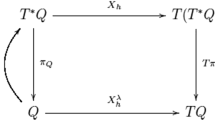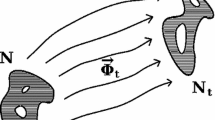Abstract
Relational formulations of classical mechanics and gravity have been developed by Julian Barbour and collaborators. Crucial to these formulations is the notion of shape space. We indicate here that the metric structure of shape space allows one to straightforwardly define a quantum motion, a Bohmian mechanics, on shape space. We show how this motion gives rise to the more or less familiar theory in absolute space and time. We find that free motion on shape space, when lifted to configuration space, becomes an interacting theory. Many different lifts are possible corresponding in fact to different choices of gauges. Taking the laws of Bohmian mechanics on shape space as physically fundamental, we show how the theory can be statistically analyzed by using conditional wave functions, for subsystems of the universe, represented in terms of absolute space and time.


Similar content being viewed by others
Notes
For more details on this issue, see, e.g., [18] and reference therein.
Here and in the following examples the conformal factors are modulo dimensional factors.
The general form of the guiding equation is
$$\begin{aligned} \frac{d\vec {\mathsf {Q}}_\alpha }{dt} = \frac{\hbar }{m_\alpha } \mathrm {Im} \frac{\Psi {}^* \vec {\nabla }_\alpha \Psi {}}{\Psi {}^* \Psi {}} ( \vec {\mathsf {Q}}_1, \dots ,\vec {\mathsf {Q}}_N )\,. \end{aligned}$$If \(\Psi {}\) is spinor-valued, the products in numerator and denominator should be understood as scalar products. If external magnetic fields are present, the gradient should be understood as the covariant derivative, involving the vector potential.
Our goal is to show that the simplest dynamics on shape space leads to a nontrivial dynamics in a suitable gauge. The case \({\mathscr {V}}\ne 0\) will be considered in the next subsection.
This corresponds to the fact that the subspaces of the tangent spaces (at the points in absolute configuration space) orthogonal to the fibers don’t correspond to a foliation of absolute configuration space into submanifolds orthogonal to the fibers. This is related to the fact that the curvature of the connection relating the tangent spaces sitting at different points is non-vanishing and this, in its turn, is related to the Berry phase.
Moreover, the vertical vector fields that we shall need correspond to the Lie algebra of G, which is noncommutative, and thus do not arise from a coordinate system.
Formula (102) is probably in the literature, but we have not succeeded in finding any reference. It is a straightforward consequence, for a manifold with a distinguished volume form (up to sign), of the fact that the divergence of a vector field times the volume form is the exterior derivative of the contraction of the vector field with the volume form.
Identifying \({\mathscr {F}}\) and \({\mathscr {E}}\) with the \(\sigma \)-algebras they generate, consisting of the measurable sets that are unions of the leaves of the respective foliations
Letting \(\varvec{x}\) and \(\varvec{y}\) be the configuration variables of system and environment, respectively, note that if f does not depend on \(\varvec{x}\), the kinetic energy term in the Hamiltonian (84) will be
$$\begin{aligned} -\frac{\hbar ^2}{2} \left[ \frac{1}{f} ( \varvec{\nabla }^2 )_{\varvec{x}}+ ( \varvec{\nabla }\varvec{\cdot }\frac{1}{f}\varvec{\nabla })_{\varvec{y}} \right] \,, \end{aligned}$$where \(\varvec{\nabla }\) and \(\varvec{\nabla }\varvec{\cdot }\) are the mass-weighted Euclidean gradient and divergence and the subscripts refer to their restrictions to the \(\varvec{x}\)-variables and the \(\varvec{y}\)-variables, respectively. Accordingly, whenever the system is decoupled from its environment, its conditional wave function \(\widehat{\psi }_{3} (\varvec{x}) = \widehat{\Psi }_{3}(\varvec{x}, \varvec{Y}) \) will evolve (after suitable rescaling) according to the standard Schrödinger Hamiltonian with masses \( f (\varvec{Y}) m_\alpha \), \(\alpha = 1, \ldots M\), where \(\varvec{Y}\) is the actual configuration of the environment. Thus, in this case, the effect of the environment on the system corresponds just to a (possibly time-dependent) rescaling of the masses. Then it turns out that the 3-gauge is more similar to the Schrödinger gauge than one may have expected.
This seems to involve a new sort of conditional probability analogous to the so-called Palm measure. In particular, it does not appear to be a special case of the conditional distribution relative to a \(\Sigma \)-algebra or a foliation or given the value of another random variable. That is because any path will involve configurations with many different environments Y.
When \(\Psi _t\) is time-dependent, it is natural to suppose that the time-parameter t has physical significance via the changes in typical configurations arising from changes in \(\mu ^{\Psi _t}\). In this situation, treating time as if it were physical and observable seems to be a reasonable approximation. In any case, this is an approximation we almost always make, and it seems to often work quite well.
Note that, as a consequence of Poincaré recurrence, in general there might be no time function associated with a dynamics T. However, if one does exist, it cannot be unique, because it would depend on the choice of an initial cross section.
These formulas, for the different gauges, may appear to be incompatible. But for the condition relating \(\Psi \) and the time-parameter to hold for both the Schrödinger gauge and any other gauge, the condition on f mentioned above would presumably have to be satisfied, in which case the formulas would agree.
References
Anderson, E.: The problem of time and quantum cosmology in the relational particle mechanics arena (2011). arXiv:1111.1472
Anderson, E.: The problem of time in quantum gravity. Ann. Phys. 524, 757–786 (2012)
Barbour, J.: Scale-invariant gravity: particle dynamics. Class. Quantum Gravity 20, 1543 (2003)
Barbour, J.: Shape dynamics. A Introduction. In: Finster, F., Muller, O., Nardmann, M., Tolksdorf, J., Zeidler, E. (eds.) Quantum Field Theory and Gravity, pp. 257–297. Springer, New York (2012)
Barbour, J.B., Bertotti, B.: Mach’s principle and the structure of dynamical theories. Proc. R. Soc. Lond. A 382, 295–306 (1982)
Barbour, J., Foster, B.Z., Ó Murchadha, N.: Relativity without relativity. Class. Quantum Gravity 19, 3217 (2002)
Bell, J.S.: Speakable and Unspeakable in Quantum Mechanics. Cambridge University Press, Cambridge (1987)
Bohm, D.: A suggested interpretation of the quantum theory in terms of“ hidden” variables. I. Phys. Rev. 85, 166 (1952)
Bricmont, J.: Making Sense of Quantum Mechanics. Springer, New York (2016)
DeWitt, B.S.: Spacetime as a sheaf of geodesics in superspace. In: Carmeli, M., Fickler, S.I., Witten, L. (eds.) Relativity, pp. 359–374. Springer, New York (1970)
Dürr, D., Goldstein, S., Zanghì, N.: Quantum equilibrium and the origin of absolute uncertainty. J. Stat. Phys. 67, 843–907 (1992)
Dürr, D., Goldstein, S., Zanghì, N.: Quantum Physics Without Quantum Philosophy. Springer, New York (2012)
Gomes, H., Gryb, S., Koslowski, T.: Einstein gravity as a 3d conformally invariant theory. Class. Quantum Gravity 28, 045005 (2011)
Gryb, S.: Jacobi’s principle and the disappearance of time. Phys. Rev. D 81, 044035 (2010)
Kendall, D.G.: The diffusion of shape. Adv. Appl. Probab. 9, 428–430 (1977)
Kendall, D.G., Barden, D., Carne, T.K., Le, H.: Shape and Shape Theory. John, New York (2009)
Koslowski, T.: Quantum inflation of classical shapes. Found. Phys. 47, 625–639 (2017)
Le, H., Kendall, D.G.: The Riemannian structure of Euclidean shape spaces: a novel environment for statistics. Ann. Stat. 21, 1225–1271 (1993)
Marques, F.C.: Scalar curvature, conformal geometry, and the Ricci flow with surgery. In: Proceedings of the International Congress of Mathematicians 2010, pp. 811–829. World Scientific, Singapore (2010)
Mercati, F.: Shape Dynamics: Relativity and Relationalism. Oxford University Press, Oxford (2018)
Small, C.G.: The Statistical Theory of Shape. Springer, New York (2012)
Vassallo, A., Ip, P.H.: On the conceptual issues surrounding the notion of relational Bohmian dynamics. Found. Phys. 46, 943–972 (2016)
Acknowledgements
We are grateful to Florian Hoffmann for his input to a very early draft of this paper and to Antonio Vassallo for his insights. We thank Sahand Tokasi for stimulating discussions. We thank Eddy Chen and Roderich Tumulka for a careful reading of the manuscript and useful suggestions. The many discussions with Julian Barbour are gratefully acknowledged, especially for sharing with us in his well known enthusiastic way his ideas on shape dynamics. N. Zanghí was supported in part by INFN.
Author information
Authors and Affiliations
Corresponding author
Additional information
Communicated by Giovanni Gallavotti.
To Joel, an invaluable friend and colleague.
Publisher's Note
Springer Nature remains neutral with regard to jurisdictional claims in published maps and institutional affiliations.
Appendix: Some Facts About Second-Order Partial Differential Operators
Appendix: Some Facts About Second-Order Partial Differential Operators
In local coordinates, any second order partial differential operator (PDO) with real coefficients, self-adjoint with respect to some volume element \(\mu (dq)\) is of the form
with symmetric matrix function \(A= (A^{ij} ) \), vector \(B =(B^i) \), and scalar \(C\). So it can be compactly written as
Note that, while the explicit functions \(A= A(q)\), \(B= B(q)\) and \(C=C(q)\) depend on the coordinate system chosen, A is in fact a tensor, so that the fact that two second order PDOs L and \(L'\) have equal A-parts (pure second-derivative parts) is invariant.
Note that for a Laplace–Beltrami operator \(C=0\). Moreover, we shall need the A-part of the Laplace–Beltrami operator with respect to the invariant metric \(g= f g_e\), where \(g_e\) is the mass-weighted Euclidean metric. According to (68), we have
where I is the identity matrix.
Here are some relevant facts: Suppose \({\mathsf {L}}\) and \({\mathsf {L}}' \) are second order PDOs on a manifold M. If
-
1.
they have the same A-part, and
-
2.
are self-adjoint with respect the same measure \(\mu \),
then they differ by at most a multiplication operator \(D=D(q)\), i.e.,
This is so because their difference, which must be of the form \(B\cdot \nabla + D\), must also be self adjoint. Since D is as well, \(B\cdot \nabla \) must also be. But for no measure \(\mu \) can \(B\cdot \nabla \) be self-adjoint on \(L^2(d\mu )\), unless \(B=0\). Moreover, if \({\mathsf {L}}\) has no \(C\)-part, then
where 1 is the constant function equal to 1.
Rights and permissions
About this article
Cite this article
Dürr, D., Goldstein, S. & Zanghí, N. Quantum Motion on Shape Space and the Gauge Dependent Emergence of Dynamics and Probability in Absolute Space and Time. J Stat Phys 180, 92–134 (2020). https://doi.org/10.1007/s10955-019-02362-9
Received:
Accepted:
Published:
Issue Date:
DOI: https://doi.org/10.1007/s10955-019-02362-9




